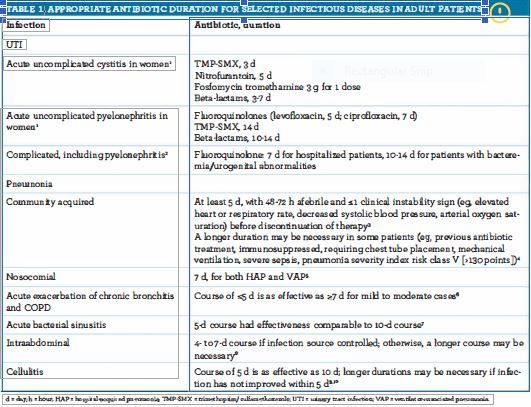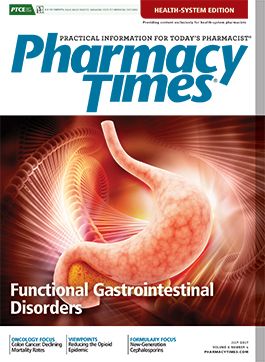Publication
Article
Pharmacy Practice in Focus: Health Systems
Duration of Antibiotic Therapy: General Principles
Deciding on the duration of antimicrobial therapy for an infection is neither straightforward nor simple.
Deciding on the duration of antimicrobial therapy for an infection is neither straightforward nor simple. Most recommendations in infectious disease guidelines are based on either expert opinions or evidence-based medicine. A short or long course of antibiotics can be given to a patient, depending on the drug used, the severity of an infection, and response to treatment (Table 1).
Although antibiotics are, in general, safe, they also have many risks associated with their use, including the development of allergic reactions, Clostridium difficile infection, and antibiotic resistance, as well as a higher price tag. As such, many clinicians prefer prescribing a shorter treatment course. However, it also is important to provide a substantial treatment course so that an infection is treated adequately and relapse is prevented. This article is a review of the general principles for setting optimal antibiotic durations of therapy.
CHOICE OF AGENT
Antibiotics work by either selectively killing (bactericidal) or inhibiting the growth (bacteriostatic) of bacteria. Infections with a high bacterial burden, such as those seen in infective endocarditis, require treatment with antibiotics with rapid bactericidal activity. In most cases, more than 1 antibiotic is used to provide synergistic activity and rapid killing. For example, when treating native valve endocarditis caused by penicillin-susceptible viridans streptococci, the usual treatment duration can vary from 2 to 4 weeks. If penicillin G or ceftriaxone monotherapy is prescribed, the treatment duration should be 4 weeks; however, if either antibiotic is used in combination with an aminoglycoside, then the treatment can be shortened by 2 weeks.11
Another factor that can affect the efficacy of antibiotics is their ability to penetrate and remain (for an adequate time) at the site of infection. Fosfomycin tromethamine, quinolones, nitrofurantoin, trimethoprim-sulfamethoxazole and beta-lactams are some of the antibiotics used to treat urinary tract infections. Even though these antibiotics can concentrate well in the genitourinary tract, each can differ in duration of treatment. For example, fosfomycin can be given in a 1-time dose because a single 3-g oral dose can provide a peak urinary concentration within 4 hours and remain elevated (>128 mg/L) for ≤48 hours.12 In another example, Hooton et al found that a 3-day course of cefpodoxime proxetil, a third-generation cephalosporin, did not provide a similar cure rate as it did with a 3-day regimen of ciprofloxacin (cure rate, 82% vs 93%, respectively; 95% CI, 3%-18%) for the treatment of acute uncomplicated cystitis.13
TYPE AND SEVERITY OF INFECTION
A patient’s immune status, affected anatomical site, and pathogen causing the infection also should be considered when assessing duration of therapy. Infected patients with no hemodynamic issues can be treated with short courses of antimicrobials. For example, community-acquired pneumonia (CAP) can be treated in as little as 5 days, but once the patient’s condition is complicated by bacteremia or severe sepsis, a longer course of antibiotics is essential.3
The ability of antibiotics to penetrate necrotic tissues, abscesses, or biofilms also can limit their efficacy. Infections can be difficult to treat and require prolonged antibiotic courses. Unless surgical intervention is undertaken to remove debris and/ or drain abscesses, antibiotics cannot reach infected sites. For example, a course of antibiotics for intraabdominal infections is no longer than 7 days; however, if it is difficult to perform the source control procedure (eg, drain infected foci, control ongoing peritoneal contamination), a longer treatment course is necessary.8
ASSESSMENT OF PATIENT’S RESPONSE
Improvements in hemodynamic status (eg, heart rate, blood pressure), white blood cell count, temperature, oxygenation, and/or radiologic findings should be seen a few days after starting an effective therapy. Once the signs and symptoms of infections are resolved, clinicians can consider terminating therapy. El Moussaoui et al conducted a randomized, double-blind, placebo-controlled study comparing the effectiveness of discontinuing amoxicillin therapy in mild to moderate-severe CAP after 3 days compared with 8 days.14 Patients were assessed regarding4 respiratory symptoms (dyspnea, cough, sputum production, color of sputum) and general improvement (not recovered to complete recovery) based on a 5-point symptom scale. Patients who improved by ≥2 points, who had a temperature <38°C, and who were able to take oral medications were randomized to receive either 750-mg oral amoxicillin or placebo for 3 to 5 days. They found that discontinuing antibiotics 3 days after symptom resolution did not adversely affect patient outcomes. In addition, there were no differences in clinical or radiological outcomes between the 2 groups after 10 days and 28 days.14
Rechecking for cultures is not always necessary once a patient begins responding to therapy, except in the case of bloodstream infections. Monitoring for bacterial clearance is crucial because day 1 of antimicrobial therapy is the first day on which negative blood cultures are obtained.15 Acquiring unnecessary cultures should be avoided because a positive culture having no signs and symptoms of infection could lead to treating colonized bacteria.
The use of biomarkers, such as C-reactive protein (CRP), and the procalcitonin test also has been instrumental in evaluating antibiotic response and determining the duration of antibiotic therapy. Unlike CRP, procalcitonin is more specific to bacterial infections; therefore, the test has been used to curtail unnecessary antibiotic usage. Use of the procalcitonin-guided algorithm has been shown to reduce the duration of exposure to antibiotics by ≤25% in patients with lower respiratory tract infections16 and 23% in patients who are critically ill.17
CONCLUSION
Pharmacists are vital team members in antibiotic stewardship. Thus, they should have a good understanding of the ways in which antibiotics work and the factors that affect their efficacy. In addition, they must be able to monitor for responses to antibiotics to ensure that patients are treated adequately and infection relapses are prevented.
References
1. Gupta K, Hooton TM, Naber KG, et al; Infectious Diseases Society of America; European Society for Microbiology and Infectious Diseases. International clinical practice guidelines for the treatment of acute uncomplicated cystitis and pyelonephritis in women: a 2010 update by the Infectious Diseases Society of America and the European Society for Microbiology and Infectious Diseases. Clin Infect Dis. 2011; 52(5):e103-e120. doi: 10.1093/cid/ciq257.
2. Eliakim-Raz N, Yahav D, Paul M, Leibovici L. Duration of antibiotic treatment for acute pyelonephritis and septic urinary tract infection—7 days or less versus longer treatment: systematic review and meta-analysis of randomized controlled trials. J Antimicrob Chemother. 2013;68(10):2183-2191. doi: 10.1093/jac/dkt177.
3. Mandell LA, Wunderink RG, Anzueto A, et al; Infectious Diseases Society of America; American Thoracic Society. Infectious Diseases Society of America/American Thoracic Society consensus guidelines on the management of community-acquired pneumonia in adults. Clin Infect Dis. 2007;44(suppl 2):S27-S72.
4. Uranga A, España PP, Bilbao A, et al. Duration of antibiotic treatment in community-acquired pneumonia: a multicenter randomized clinical trial. JAMA Intern Med. 2016;176(9):1257-1265. doi: 10.1001/jamainternmed.2016.3633.
5. Kalil AC, Metersky ML, Klompas M, et al. Management of adults with hospital-acquired and ventilator-associated pneumonia: 2016 clinical practice guidelines by the Infectious Diseases Society of America and the American Thoracic Society. Clin Infect Dis. 2016;63:e61-111.
6. El Moussaoui R, Roede BM, Speelman P, et al. Short-course antibiotic treatment in acute exacerbations of chronic bronchitis and COPD: a meta-analysis of double-blind studies. Thorax. 2008;63(5):415-422. doi: 10.1093/cid/ciw504.
7. Falagas ME, Karageorgopoulos DE, Grammatikos AP, Matthaiou DK. Effectiveness and safety of short vs. long duration of antibiotic therapy for acute bacterial sinusitis: a meta-analysis of randomized trials. Br J Clin Pharmacol. 2009;67(2):161-171. doi: 10.1111/j.1365-2125.2008.03306.x.
8. Solomkin JS, Mazuski JE, Bradley JS, et al. Diagnosis and management of complicated intra-abdominal infection in adults and children: guidelines by the Surgical Infection Society and the Infectious Diseases Society of America [erratum in Clin Infect Dis. 2010; 50(12):1695]. Clin Infect Dis. 2010;50(2):133-164. doi: 10.1086/649554.
9. Hepburn MJ, Dooley DP, Skidmore PJ, Ellis MW, Starnes WF, Hasewinkle WC. Comparison of short-course (5 days) and standard (10 days) treatment for uncomplicated cellulitis. Arch Intern Med. 2004;164(15):1669-1674.
10. Stevens DL, Bisno AL, Chambers HF, et al. Practice guidelines for the diagnosis and management of skin and soft tissue infections: 2014 update by the Infectious Diseases Society of America. Clin Infect Dis. 2014;59(2):147-159. doi: 10.1093/cid/ciu296.
11. Baddour LM, Wilson WR, Bayer AS, et al; American Heart Association Committee on Rheumatic Fever, Endocarditis, and Kawasaki Disease of the Council on Cardiovascular Disease in the Young, Council on Clinical Cardiology, Council on Cardiovascular Surgery and Anesthesia, and Stroke Council. Infective endocarditis in adults: diagnosis, antimicrobial therapy, and management of complications: a scientific statement for healthcare professionals from the American Heart Association. Circulation. 2015;132(15):1435-1486. doi: 10.1161/CIR.0000000000000296.
12. Patel SS, Balfour JA, Bryson HM. Fosfomycin tromethamine. A review of its antibacterial activity, pharmacokinetic properties, and therapeutic efficacy as a single-dose oral treatment for acute uncomplicated lower urinary tract infections. Drugs. 1997;53(4):637-656.
13. Hooton TM, Roberts PL, Stapleton AE. Cefpodoxime vs ciprofloxacin for short-course treatment of acute uncomplicated cystitis: a randomized trial. JAMA. 2012;307(6):583-589. doi: 10.1001/jama.2012.80.
14. El Moussaoui R, de Borgie CA, van den Broek P, et al. Effectiveness of discontinuing antibiotic treatment after three days versus eight days in mild to moderate-severe community acquired pneumonia: randomised, double blind study. BMJ. 2006;332(7554):1355.
15. Mermel LA, Allon M, Bouza E, et al. Clinical practice guidelines for the diagnosis and management of intravascular catheter-related infection: 2009 update by the Infectious Diseases Society of America. Clin Infect Dis. 2009;49(1):1-45. doi: 10.1086/599376.
16. Schuetz P, Christ-Crain M, Thomann R, et al; ProHOSP Study Group. Effect of procalcitonin-based guidelines vs standard guidelines on antibiotic use in lower respiratory tract infections: the ProHOSP randomized controlled trial. JAMA. 2009;302(10):1059-1066. doi: 10.1001/jama.2009.1297.
17. Bouadma L, Luyt CE, Tubach F et al; PRORATA trial group. Use of procalcitonin to reduce patients’ exposure to antibiotics in intensive care units (PROATA trial): a multicentre randomised controlled trial. Lancet. 2010;375(9713):463-474. doi: 10.1016/S0140-6736(09)61879-1.








